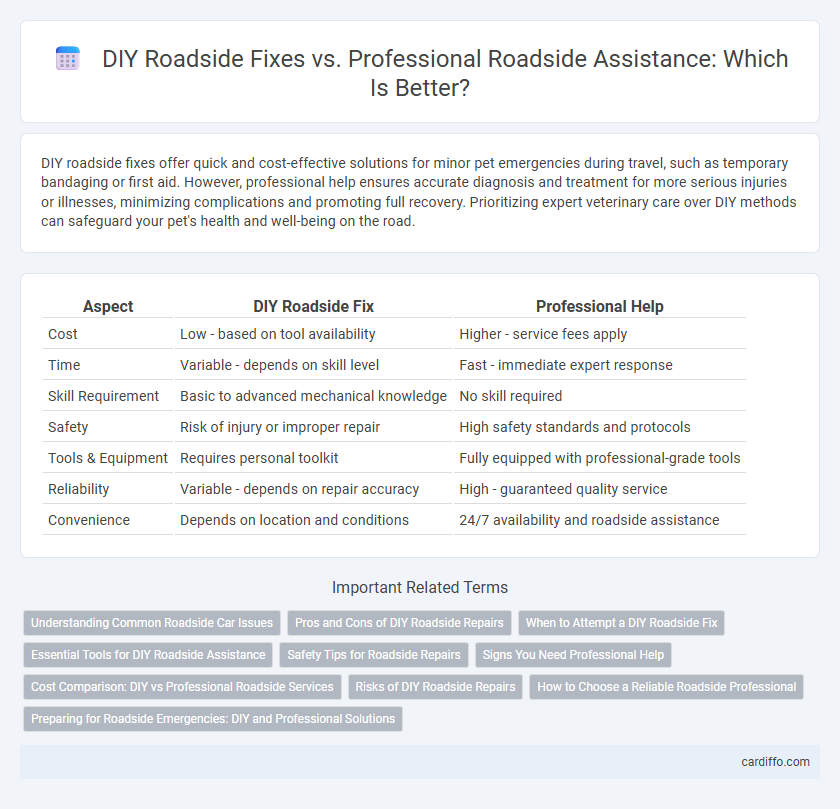DIY roadside fixes offer quick and cost-effective solutions for minor pet emergencies during travel, such as temporary bandaging or first aid. However, professional help ensures accurate diagnosis and treatment for more serious injuries or illnesses, minimizing complications and promoting full recovery. Prioritizing expert veterinary care over DIY methods can safeguard your pet's health and well-being on the road.
Table of Comparison
| Aspect | DIY Roadside Fix | Professional Help |
|---|---|---|
| Cost | Low - based on tool availability | Higher - service fees apply |
| Time | Variable - depends on skill level | Fast - immediate expert response |
| Skill Requirement | Basic to advanced mechanical knowledge | No skill required |
| Safety | Risk of injury or improper repair | High safety standards and protocols |
| Tools & Equipment | Requires personal toolkit | Fully equipped with professional-grade tools |
| Reliability | Variable - depends on repair accuracy | High - guaranteed quality service |
| Convenience | Depends on location and conditions | 24/7 availability and roadside assistance |
Understanding Common Roadside Car Issues
Common roadside car issues include flat tires, dead batteries, and overheated engines, which many drivers can address with basic DIY skills and tools. Proper knowledge of each problem's symptoms, such as a flat tire's sudden loss of pressure or a dead battery causing starting failure, enhances the chances of a successful roadside repair. However, complex issues like transmission failure or brake system malfunctions often require professional help to ensure safety and prevent further vehicle damage.
Pros and Cons of DIY Roadside Repairs
DIY roadside repairs offer immediate cost savings and convenience by allowing drivers to address minor issues like flat tires or battery jumps without waiting for professional assistance. However, the limitations of DIY methods include potential safety risks, incomplete fixes, and a lack of specialized tools or expertise required for complex problems. Professional roadside help ensures thorough diagnostics and reliable repairs, but it often comes with higher costs and longer wait times.
When to Attempt a DIY Roadside Fix
Attempt a DIY roadside fix only when the problem is minor, such as changing a flat tire or jump-starting a battery, and you have the necessary tools and knowledge. Complex issues like transmission failure or brake system malfunctions require professional assistance to ensure safety and prevent further damage. Always assess the situation's risk and your own experience before deciding to handle roadside repairs independently.
Essential Tools for DIY Roadside Assistance
Essential tools for DIY roadside assistance include a reliable jack, jumper cables, a tire pressure gauge, and a multi-tool for quick repairs. Carrying a flashlight with extra batteries, reflective warning triangles, and a first aid kit enhances safety and preparedness during emergencies. While DIY fixes can address minor issues efficiently, having these tools ensures readiness and can reduce dependence on professional help for basic roadside problems.
Safety Tips for Roadside Repairs
Performing DIY roadside repairs can save time and money, but prioritizing safety is crucial to avoid accidents; always ensure your vehicle is parked on a flat, stable surface away from traffic and use hazard lights and reflective triangles to alert other drivers. Wearing high-visibility clothing and having a fire extinguisher readily accessible can further enhance safety during repairs. For complex issues or unsafe conditions, seeking professional roadside assistance minimizes risk and ensures proper, efficient vehicle recovery.
Signs You Need Professional Help
Persistent engine warning lights, unusual noises during driving, and repeated roadside breakdowns signal the need for professional roadside assistance. Complex mechanical issues, such as transmission problems or brake failures, require specialized diagnostic tools and expertise beyond typical DIY repairs. Promptly consulting a certified mechanic ensures safety and prevents further vehicle damage on the roadside.
Cost Comparison: DIY vs Professional Roadside Services
DIY roadside fixes typically cost significantly less than professional services, often requiring only basic tools and spare parts priced under $50. Professional roadside assistance averages $60 to $100 per call, factoring in service fees, labor, and travel costs. While DIY repairs save money upfront, complex issues may incur higher expenses if improper fixes lead to further damage.
Risks of DIY Roadside Repairs
DIY roadside repairs pose significant risks including improper diagnosis, use of incorrect tools, and potential injury due to lack of expertise. Mistakes can worsen vehicle damage, leading to costly repairs and unsafe driving conditions. Professional roadside assistance ensures expert evaluation, proper equipment, and reliable fixes that prioritize safety and vehicle integrity.
How to Choose a Reliable Roadside Professional
Choosing a reliable roadside professional involves verifying certifications, reading customer reviews, and ensuring the service provider offers 24/7 availability with transparent pricing. Trusted roadside experts use advanced diagnostic tools and comply with safety standards, ensuring quick and effective vehicle repairs. Prioritizing professionals backed by roadside assistance programs or automotive associations guarantees quality and peace of mind during emergencies.
Preparing for Roadside Emergencies: DIY and Professional Solutions
Preparing for roadside emergencies involves equipping your vehicle with essential DIY tools like a tire repair kit, jumper cables, and a first-aid kit to handle minor repairs and safety needs. Understanding when to apply DIY fixes versus calling professional roadside assistance ensures timely and effective resolution, minimizing risks during breakdowns or accidents. Professional services offer advanced diagnostics, towing, and complex repairs, providing critical support when DIY measures are insufficient or unsafe.
DIY Roadside Fix vs Professional Help Infographic

 cardiffo.com
cardiffo.com